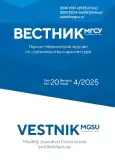Введение. Строительная отрасль считается одной из основных причин ухудшения состояния окружающей среды из-за использования традиционных строительных материалов, таких как цемент. В результате возникает острая необходимость в разработке устойчивых альтернатив производству экологически чистого бетона с применением натуральных необработанных материалов. Признавая важность цемента для урбанизации человечества, следует отметить, что его широкое использование, несомненно, способствует глобальному потеплению, которое угрожает окружающей среде во всем мире из-за выбросов углекислого газа, когда ископаемое топливо применяется для расплавления продуктов, которые используются при его производстве, и представляют собой смесь глины, воды и извести для получения основного связующего материала, т.е. клинкера.Материалы и методы. Цель исследования — изучение возможности замены портландцемента натуральным пуццоланом в соответствии с соотношениями замены в диапазоне от 10 до 50 %, а также изучение влияния этой замены на физические свойства, наиболее важными из которых являются теплопроводность и механические свойства, представленные сопротивлением простому давлению, с учетом следующих факторов: использование переработанного гравия в качестве альтернативы натуральному гравию.Результаты. Результаты показали, что при увеличении процентного содержания замены цемента пуццоланом повышается термостойкость бетона, так как замена цемента равной массой пуццолана приводит к снижению теплопроводности на 5 %. Кроме того, переработанные заполнители обладают большей термостойкостью по сравнению с натуральными заполнителями, даже если 50 % цемента заменено молотым пуццоланом. Отмечается увеличение стойкости более чем на 24 %, а снижение стойкости полученного бетона к простому давлению допустимо, если замена на пуццолан составляет менее 50 %.Выводы. Простые значения прочности при сжатии кубических образцов превышают минимальные пределы международных спецификаций на цементные блоки, что позволяет изготавливать цементные блоки с использованием вторичных заполнителей с возможностью замены цемента молотым пуццоланом в соответствии с различными коэффициентами замещения до 50 %.
 485-495
485-495


 496-505
496-505


 506-515
506-515


 516-528
516-528


 529-544
529-544


 545-558
545-558


 559-568
559-568


 569-583
569-583


 584-595
584-595


 596-614
596-614







